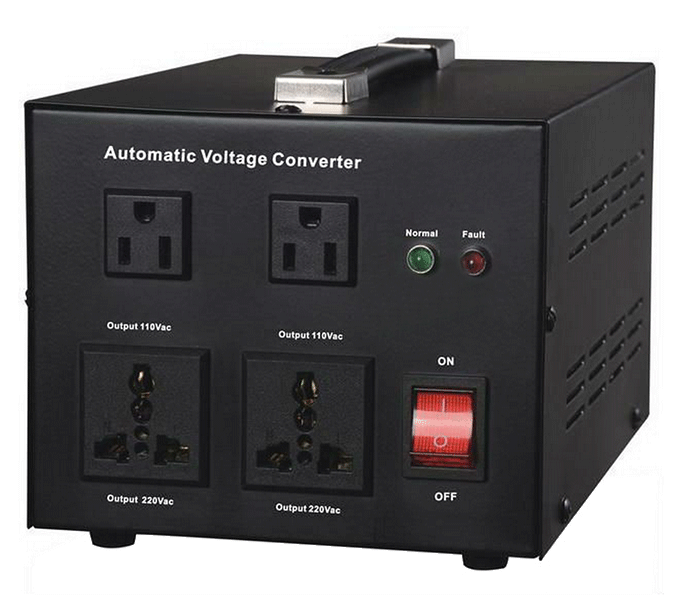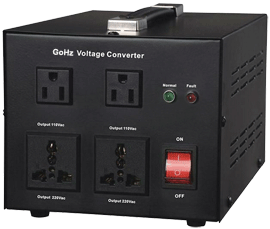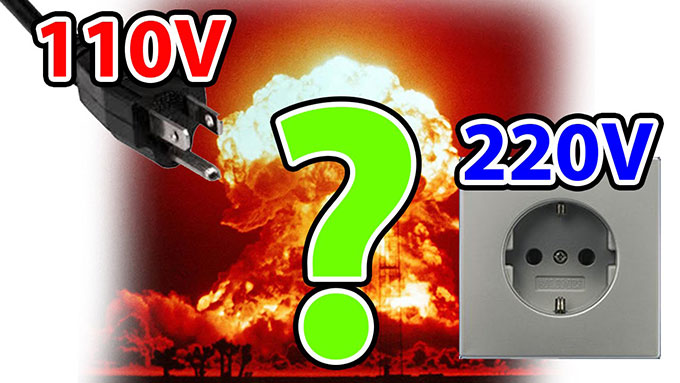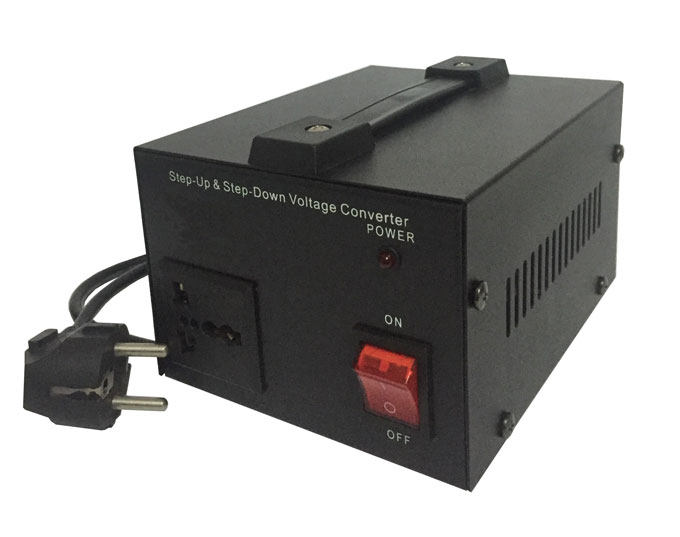Using 110v Appliances in 220v Countries
Have you ever purchased a foreign electrical product?
A friend said the rice cooker he bought from Japan cannot be used at home. In fact, not only Japan's rice cooker, the coffee machines, ovens and other appliances from the United States are not easy to use at home.
Why?
That is because many countries use 220V AC, while Japan uses 100V AC, and the US uses 110V AC outlet. Electrical appliances of these countries are designed to adapt to the local voltage level. Electrical appliances with high rated voltages may not operate when plugged into a low-voltage power source. If a low rated voltage is inserted into a high voltage power supply, the appliance may be burned out.
In other words, if a Japanese original electrical appliance is directly used under 220v, it will be broken. Especially, for voltage and current sensitive smart chip, it will easy to be burned, and hard to be repaired and replaced, the cost may also be very expensive.
The only solution is to convert the 220V home electric into 110V, so be sure to use the voltage converter. Some people may think that voltage converting is very simple? A travel plug can do the job! Actually, it can't. Common conversion plug power is only 60W, but household appliances power generally much higher, such as rice cooker power is at least 600W, most common is 1000W-1500W. To be safe, you'll need a GoHz voltage converter.
In fact, the current global civil exchange standard voltages are two:
220V region (220~240V): China, Britain, Germany, Australia, Singapore and more than 120 countries and regions
110V region (100~130V): the United States, Canada, Japan, China Taiwan and more than 30 countries and regions
Buying electrical appliances from abroad, we must first consider whether they cannot be used. If not, then you need to equip the voltage converter to get your appliance working properly.

Q: Why are there so many different voltage levels? Can they be unified?
A: At the end of the 19th century, the United States took the lead in adopting the 110V voltage specification and built the 110V/60Hz standard grid. Soon, Europe introduced the AC power transmission technology. But, the 110V voltage is too low, transmission loss is too high, in order to improve this situation, Europe using the 220V voltage specification. So the European countries use the form of 220V/50Hz AC grid standards.
The industrial system of each country has been formed for more than 100 years, and cannot be subversive unified revision.
Q: 50Hz and 60Hz frequency is different. Do they have effect on appliance using?
A: For general household appliances, under the same the voltage, after access to electrical power, the 50Hz is lower than 60Hz, but it will not cause too much impact, you can normally use.
A friend said the rice cooker he bought from Japan cannot be used at home. In fact, not only Japan's rice cooker, the coffee machines, ovens and other appliances from the United States are not easy to use at home.
Why?
That is because many countries use 220V AC, while Japan uses 100V AC, and the US uses 110V AC outlet. Electrical appliances of these countries are designed to adapt to the local voltage level. Electrical appliances with high rated voltages may not operate when plugged into a low-voltage power source. If a low rated voltage is inserted into a high voltage power supply, the appliance may be burned out.
In other words, if a Japanese original electrical appliance is directly used under 220v, it will be broken. Especially, for voltage and current sensitive smart chip, it will easy to be burned, and hard to be repaired and replaced, the cost may also be very expensive.
The only solution is to convert the 220V home electric into 110V, so be sure to use the voltage converter. Some people may think that voltage converting is very simple? A travel plug can do the job! Actually, it can't. Common conversion plug power is only 60W, but household appliances power generally much higher, such as rice cooker power is at least 600W, most common is 1000W-1500W. To be safe, you'll need a GoHz voltage converter.
In fact, the current global civil exchange standard voltages are two:
220V region (220~240V): China, Britain, Germany, Australia, Singapore and more than 120 countries and regions
110V region (100~130V): the United States, Canada, Japan, China Taiwan and more than 30 countries and regions
Buying electrical appliances from abroad, we must first consider whether they cannot be used. If not, then you need to equip the voltage converter to get your appliance working properly.

Q: Why are there so many different voltage levels? Can they be unified?
A: At the end of the 19th century, the United States took the lead in adopting the 110V voltage specification and built the 110V/60Hz standard grid. Soon, Europe introduced the AC power transmission technology. But, the 110V voltage is too low, transmission loss is too high, in order to improve this situation, Europe using the 220V voltage specification. So the European countries use the form of 220V/50Hz AC grid standards.
The industrial system of each country has been formed for more than 100 years, and cannot be subversive unified revision.
Q: 50Hz and 60Hz frequency is different. Do they have effect on appliance using?
A: For general household appliances, under the same the voltage, after access to electrical power, the 50Hz is lower than 60Hz, but it will not cause too much impact, you can normally use.
I am moving to the Philippines where most power outlets have 220v 50hz. All of our kitchen small appliances are of 110v 60hz. I know I need Step-down converters to use these with 220v. How about the frequency? Does a typical step-down transformers convert frequency too? How about power tool battery chargers?
Thanks it's informative
how can i run 110v cir-cute breaker in DB in india
I just bought a Nesspresso coffee maker from Japan and want to use it here in the United States please help me figure out what do I need..thank you..
Hi,
I'm returning to the UK from Japan this year and am trying to understand which transformer I need to buy. Family has a couple of laptops and a bunch of other electrical household goods that we bought whilst in Japan.
Thanks in advance.
Jason
I'm returning to the UK from Japan this year and am trying to understand which transformer I need to buy. Family has a couple of laptops and a bunch of other electrical household goods that we bought whilst in Japan.
Thanks in advance.
Jason
Post a Comment:
You may also like:

With a Voltage Converter, you can convert
110v to 220v;
120v to 220v;
220v to 110v;
230v to 110v;
240v to 110v.
Note, voltage converters do NOT convert 50Hz to 60Hz, or 60Hz to 50Hz.
Featured Articles
What Happens When an Appliance is ...
 If the 110V appliance is connected to a 220V power supply, the power may quadruple at the moment the appliance switched on, and ...
If the 110V appliance is connected to a 220V power supply, the power may quadruple at the moment the appliance switched on, and ...
 If the 110V appliance is connected to a 220V power supply, the power may quadruple at the moment the appliance switched on, and ...
If the 110V appliance is connected to a 220V power supply, the power may quadruple at the moment the appliance switched on, and ...Automatic 220v to 110v Voltage ...
 As we know, electric voltage of some countries and regions is 220V. But in America, the electric voltage is generally 110V. When ...
As we know, electric voltage of some countries and regions is 220V. But in America, the electric voltage is generally 110V. When ...
 As we know, electric voltage of some countries and regions is 220V. But in America, the electric voltage is generally 110V. When ...
As we know, electric voltage of some countries and regions is 220V. But in America, the electric voltage is generally 110V. When ...Voltage Difference between US and UK
 Many people who travel to the United States found it difficult to use their electronic devices, because of different power supply ...
Many people who travel to the United States found it difficult to use their electronic devices, because of different power supply ...
 Many people who travel to the United States found it difficult to use their electronic devices, because of different power supply ...
Many people who travel to the United States found it difficult to use their electronic devices, because of different power supply ...